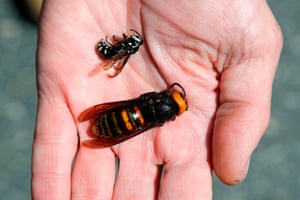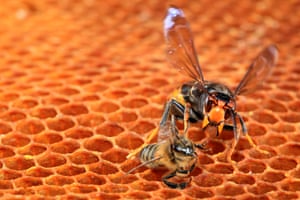It took Moufida and John Holubeshen just a day of tracing alleged sightings and studying map coordinates before the two amateur detectives found their target.
“We did the whole CSI thing,” says Moufida. “Plotting points and drawing lines, searching for where the middle of the circle – the nest – would be.”
The couple, like hundreds of other beekeepers in western Canada and the US, were hunting the Asian giant hornet, an invasive species whose stealthy advance throughout British Columbia and Washington state is causing growing unease.
Scientists and apiarists fear that, if permitted to spread unchecked, the hornets, which feast on honeybee larvae, could have disastrous consequences for tens of thousands of hives.

The couple’s investigation began last September, when word spread that hornets had been spotted on the outskirts of the city of Nanaimo where they live. Concerned for the safety of their four hives, they set out one evening towards the suspected nest location in a city park.
As they walked along the trail, they heard a low, rumbling buzz overhead. Moments later John felt a sharp pain in his chest. He had just become one of the first people to be stung by a giant hornet in North America.
“It was like being hit by a two-by-four,” he says. “It felt more like a bruised rib than a sting.”
They fled the scene – but soon realised they would have to return. “My first thought was I’ve got to go back and get a sample or a photo because nobody’s going to believe us,” he says. “It just seemed so surreal.”
As the hornet continues to spread into the Pacific northwest, government officials and local beekeepers have swapped tending hives for sleuthing: experimenting with homemade contraptions and deploying sophisticated electronics to trace the hornet’s spread – and hoping to save hundreds of thousands of honeybees in the process.

Since the first hornet was spotted, British Columbia’s chief beekeeper, Paul van Westerndorp, has been keeping a growing list of sightings. So far, the hornets have been seen in the cities of Nanaimo, White Rock and Langley.
He is well aware of the threat they pose, but still Van Westerndorp holds a deep admiration for his adversary. “I look at this animal closely and it’s fascinating. Of course, beauty is in the eye of the beholder – but it’s an incredible piece of engineering,” he says.
The Asian giant hornet, Vespa mandarinia, is built to dominate an ecosystem: its massive orange head is equipped with sharp jaws to slice through prey. When its wings flap, they sound more like a hummingbird than a wasp.
After their encounter in the park, the Holubeshens returned to the nest later that night, accompanied by entomologist Conrad Berube and Peter Lange, president of the local beekeepers’ club. Berube eradicated the subterranean hive, receiving several painful stings through his protective layers in the process.
But while the Nanaimo beachhead was successfully destroyed, the hornets’ incursion continues.
“It’s like seeing an incoming storm and battening down the hatches. But we don’t know how strong these winds are going to be,” says Susan Cormier, who, with her partner, keeps 17 hives containing about 85,000 honeybees.
Two months ago, a giant hornet was spotted nine blocks from their home in Langley, British Columbia – a city near the US border. “We’re trying our best not to panic.”

Genetic analysis of captured hornets suggests at least one came from South Korea, another from Japan. Until August 2019, no specimen had ever been spotted in Canada. And nearly a year later, no one is quite sure how they made the journey across the Pacific.
Most freight shipped across the Pacific is fumigated with carbon dioxide upon arrival to kill insects. But some cargo, such as automobiles, could provide refuge, says Van Westendorp. Others believe the hornets arrive as stowaways in oil tankers or in shipments of flower pots.
“All it needs is a tiny little space, essentially the size of its body,” says Moufida.
As the sightings have increased across the region, the media has stoked fear over an impending “murder hornet” invasion. The hornet has been known to kill people with its venom, but experts agree that the risk to the human population is low. “Most negative interactions are from people unwittingly stepping on the nests – not predatory attacks,” says Van Westendorp.
While the hornets pose relatively little threat to humans, they have an insatiable appetite for honeybees and are capable of destroying entire hives.
As summer nears, more drone hornets are expected to emerge from the subterranean nests. Scouts are dispatched to look for bee colonies, marking their location with a distinct pheromone before returning with an assault party, often weeks later.

The tactics are ruthlessly efficient: a group of 30 hornets can decapitate tens of thousands of bees in only a few hours.
“They stand at the entrance and create a massive panic in that colony, slicing the bees with their huge mandibles,” says Van Westerndorp. Amid the panic, hornets will enter the nest and pull out honeybee broods to take home as “meatballs”.
Japanese honeybees have developed a defence, vibrating their bodies as they pile on to the invading hornet to cook it alive. But honeybees in North America are defenceless.
To prevent a massacre, plans have been forged months in advance. Queen hornets briefly emerge in spring to find a nesting site, providing a narrow window in which they can be trapped, thereby preventing the development of a full-on nest.
This spring, however, none of the sticky glue traps laid out by the province and beekeeping clubs worked, says Van Westerndorp.
Still, scientists in British Columbia remain optimistic. They are using bottle traps in the hope of catching live specimens which will be tagged with small radio transmitters and followed back to the nest which can then be eradicated. Other plans include fastening a bright, thin strip of plastic ribbon to the torso of a hornet, letting the shimmering material guide beekeepers back to the nest.
US beekeepers are also looking into infrared cameras that can detect the hornet. The idea has potential, says Van Westerndorp, but he admits the technology is so far “unproven”.

Instead, beekeepers have started using low-tech approaches, modifying their hives in preparation for the summer.
“My husband has been building little screened entrances in front of our hives to try to prevent the hornets from getting in, but still allow the bees to get out,” says Cormier. “The problem is, we can’t find accurate information on how fat the Asian giant hornet is. How long is it? How big of a hole can it get into?”
For scientists and beekeepers alike, the big question is: how bad will the onslaught be?
“Maybe we’ll keep them down to a dull roar. Maybe they’ll be one of those invasive species that absolutely loves Canada and our ecosystem,” Cormier says, acknowledging the unfolding invasion is defined more by uncertainty than fear. “But nature is bigger than us. So we’ll just do what we can.”
Find more age of extinction coverage here, and follow biodiversity reporters Phoebe Weston and Patrick Greenfield on Twitter for all the latest news and features